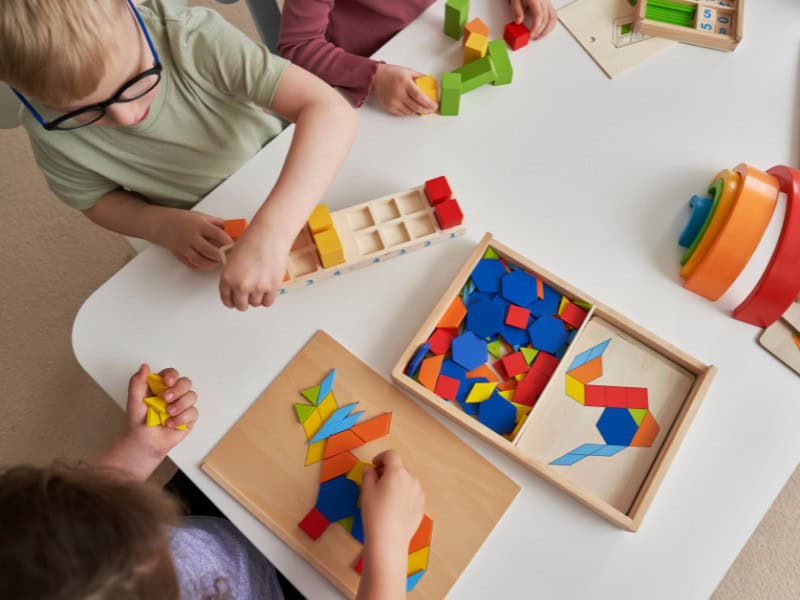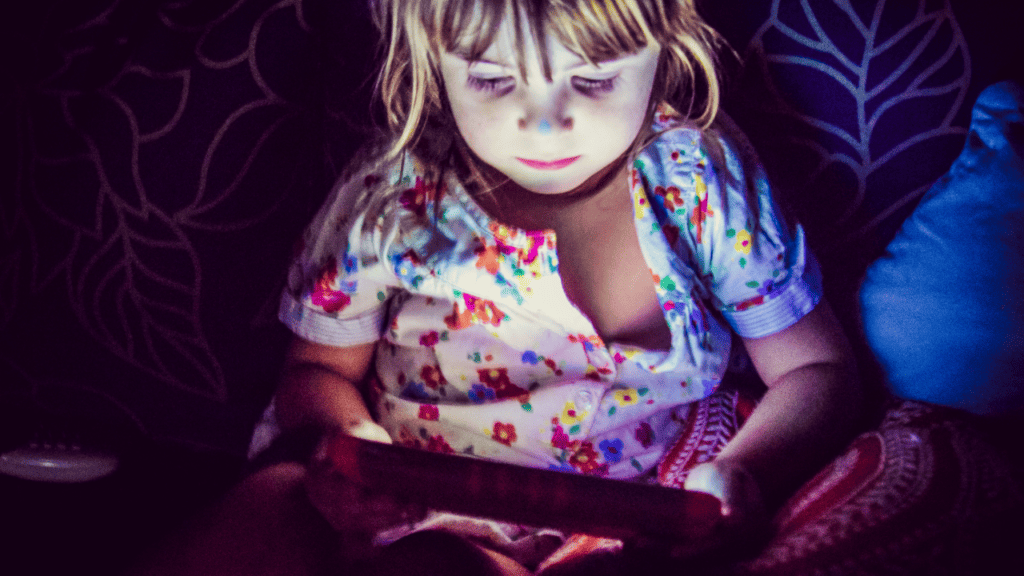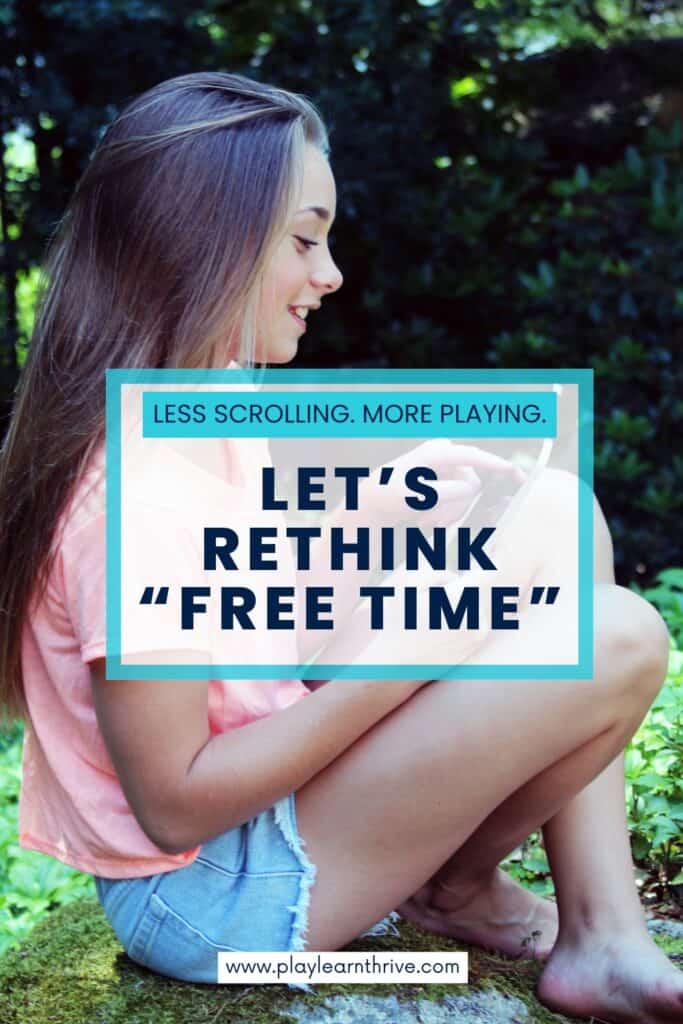Big Kids Need Play Too: Why Screens Are Replacing Play and What We Can Do About It
Big kids need play too—but screens are replacing the real-world creativity and social connection they need to thrive. Here's how we can fix it!

Play. Learn. Thrive.™ only endorses products we authentically love and use. Some of the product links in this post may be affiliate links. That means that if you click them and make a purchase, this site makes a commission. Play. Learn. Thrive.™ is also an Amazon Associate. As an Amazon Associate, we earn from qualifying purchases. It will have no impact on the price you pay or the experience of your purchase.
As children grow into adolescence, the idea of play often fades into the background, replaced by academic pressures, extracurricular commitments, and—more than anything—screens. Social media, video games, and endless digital content have rapidly become the default for how tweens and teens spend their free time. But play is just as crucial for big kids as it is for younger children, and when screen-based activities take over, kids miss out on the benefits of real-world play, movement, and social connection.
Renowned educator Maria Montessori described the 12-18 age range as a time when children become budding social justice advocates—deep thinkers who are trying to understand their place in the world. This period is marked by rapid physical, emotional, and cognitive changes, making it more important than ever for adolescents to have opportunities to decompress, explore, and express themselves through play.

Yet, in today’s screen-driven world, play for older kids is often neglected. Structured activities like sports teams and clubs dominate their schedules, while unstructured, self-directed play is rarely prioritized. Many parents assume that their big kids have outgrown play—but nothing could be further from the truth.
Before we dive in, here’s a little about me so you know you’re getting advice from someone who’s been in the trenches! I’m Alanna Gallo, a former teacher with a master’s in education who saw firsthand how kids were losing confidence, independence, and their natural love of learning. I left the classroom to help parents raise curious, capable, and screen-conscious kids in a world that doesn’t make it easy. My work has been featured in major media outlets, and I’m here to give you real, research-backed advice—without the guilt trips or unrealistic expectations.

Why Big Kids Need Play—And Why They’re Missing Out
As children grow, their need for play doesn’t disappear—it simply evolves. Play helps older kids develop:
- Social skills – Real-world play fosters deeper friendships, emotional intelligence, and teamwork.
- Resilience and stress relief – Unstructured, hands-on play helps tweens and teens manage emotions and decompress from academic or social pressures.
- Creativity and problem-solving – Engaging in open-ended, exploratory activities keeps their minds sharp and curious.
- Physical health – Movement-based play supports fitness, coordination, and overall well-being.
The problem? Many tweens and teens are missing out on these essential benefits because screens have taken over their free time.
Transform Your Family’s Screen Habits

Are digital devices dominating your family interactions? It's time for a change. Our Family Reset Mini-Course offers practical, manageable steps to significantly reduce screen time while enhancing your family's connection.
The Digital Displacement of Play
In previous generations, kids would naturally spend their free time biking around the neighborhood, climbing trees, or inventing games with friends. Now, much of that time has been replaced by passive scrolling, gaming, and digital interactions that lack the depth and engagement of real play.
Social Media: Not a Substitute for Real Socialization
Many parents assume that because their child is “hanging out” on social media, they are socializing. But social media does not provide the same benefits as face-to-face interaction and play.
- Superficial connections – A “like” or comment does not build strong friendships.
- Comparison culture – Instead of playing and experiencing life, kids are stuck watching curated versions of others’ lives, often leading to anxiety and self-doubt.
- Lost spontaneity – The pressure to “perform” online replaces the joy of unfiltered, in-the-moment playfulness.
Simply put, social media disconnects kids from real play and real people.
Video Games: Not the Play Kids Need
While video games may involve strategy and competition, they are still screen-based experiences that do not replace real-world play.
- Lack of physical movement – Sitting for hours doesn’t provide the physical benefits of outdoor play.
- Highly addictive design – Games are built to keep kids hooked, making it harder for them to transition into real-world activities.
- Reduced real-life social skills – Even multiplayer games don’t provide the face-to-face conflict resolution and emotional intelligence that real-world interactions build.
While technology is a part of modern life, it should never replace the physical, imaginative, and social experiences that real play provides.

How to Bring Back Play for Tweens and Teens
If big kids aren’t getting enough real-world play, parents have to be intentional about making space for it. The key is to limit screen distractions while providing engaging, real-world alternatives.
Encourage Movement-Based Play
With academic pressures and digital entertainment pulling kids toward more sedentary habits, physical play is more important than ever.
- Plan family hikes, bike rides, or spontaneous sports games in the backyard.
- Organize low-pressure, social movement activities like trampoline jumping, swimming, or frisbee.
- Turn music into movement—a dance party is a simple but effective way to inject play into everyday life.
- Encourage neighborhood exploration—teens who roam, climb, and adventure outdoors build confidence and independence.
Facilitate Hands-On Tinkering and Creative Play
Older kids often rediscover play when given engaging materials that spark curiosity and creativity.
- DIY projects – Woodworking, painting, or upcycling old furniture.
- Building challenges – Rube Goldberg machines, marble runs, or LEGO creations.
- Sensory activities – Yes, even big kids enjoy bubbles, dry ice experiments, or water play.
- Tinkering stations – Provide random materials like nuts, bolts, gears, and magnets to encourage hands-on exploration.
Sometimes, all it takes is giving them permission to play—teens may not reach for sidewalk chalk on their own, but if they see an adult drawing, they might grab a piece and join in.
Make Friend Time Screen-Free
One of the biggest barriers to real-world play is the presence of screens during social time. Many kids default to sitting together on their phones rather than truly interacting.
To encourage genuine, play-based connection:
- Set a “no screens during friend time” rule to promote conversation and movement.
- Create tech-free hangout spaces with board games, art supplies, or open-ended materials.
- Encourage activities that naturally engage kids away from devices, such as hiking, kayaking, or setting up obstacle courses.
Removing screens from social time helps kids rediscover how to interact, laugh, and play together.

Keeping Play Alive for Big Kids
Play is not something children outgrow—it simply evolves. Tweens and teens still need opportunities to explore, create, move, and connect, but screens have made it harder than ever for them to engage in real-world play.
As parents, we have to be deliberate about limiting digital distractions and encouraging hands-on, movement-based, and social forms of play. Big kids may not always ask for play, but they still need it—and once given the right opportunities, they’ll remember just how fun the real world can be.
By making play a priority over passive screen time, we help tweens and teens develop the social, emotional, and creative skills they need to thrive. Let’s give them the space, freedom, and permission to play—because no one is ever too old for play.
Ready to Take The Screen-Free Leap?
Be sure to check out these 50 screen-free activities! Keep on scrolling for more details!

50 Simple Screen-Free Learning Activities for Curious Kids
These 50 hands-on activities help children develop problem-solving skills, creativity, and real-world knowledge—without needing a screen. Designed to encourage self-directed play, hands-on discovery, and deep learning, this guide gives you a simple way to turn everyday moments into powerful learning opportunities.
Inspired by this post? Be sure to subscribe download my free Screen-Free Starter Kit! For more insights and resources on raising confident, lifelong learners, be sure to follow me on Instagram – can't wait for you to join me!





